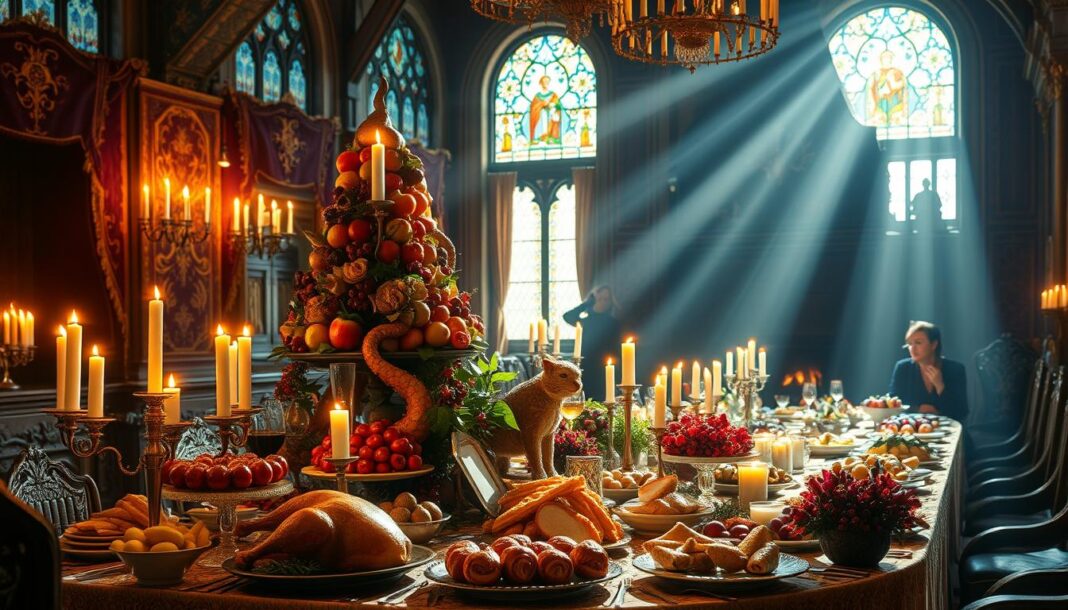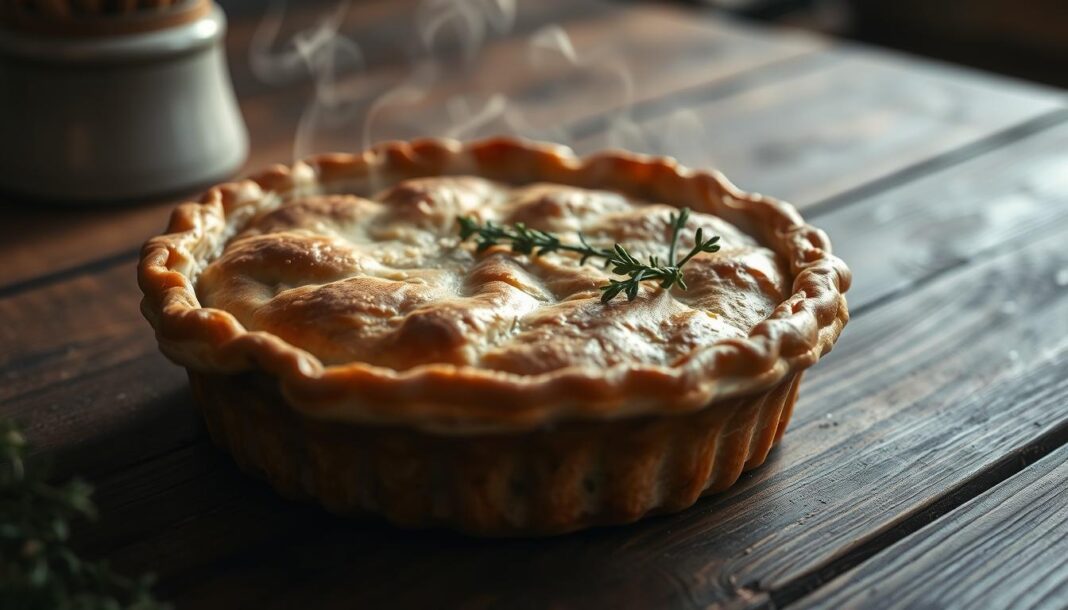In C.S. Lewis’s enchanting series, The Chronicles of Narnia, the depiction of food plays a pivotal role, evoking a sense of nostalgia and wonder. Lewis, known for his vivid descriptions, weaves food into the narrative as a symbol of nourishment, temptation, and joy.
We will explore how Lewis’s own experiences during post-war rationing influenced his lavish descriptions of meals in the fantasy world of Narnia. The various foods mentioned across the seven books create a cohesive culinary landscape, enhancing the magical quality of the series.
By examining the role of food from Narnia, we gain insight into Lewis’s storytelling techniques and the symbolic significance of culinary elements in his work.
Key Takeaways
- C.S. Lewis’s use of food imagery in The Chronicles of Narnia reflects his personal experiences and preferences.
- Food serves multiple purposes in the narrative, including plot devices and symbolic meanings.
- The culinary descriptions in Narnia create a vivid and immersive world for readers.
- Lewis’s depiction of food is influenced by his experiences during post-war rationing.
- The series presents a cohesive culinary landscape across its seven books.
The Magical Significance of Food in Narnia
Narnia, the fantastical world created by C.S. Lewis, is also a realm wherefoodholds magical significance. The way Lewis incorporatesmealsand variousfoodsinto his narrative not only enriches the world-building but also serves multiple thematic purposes.
Food as a Plot Device in C.S. Lewis’s World
C.S. Lewis deliberately used food as a crucial plot device throughout the Chronicles of Narnia. Meals often mark significant turning points in the narrative, influencing character development and the progression of the story. For instance, the contrast between the lavish feasts and the scarcity of food in different regions of Narnia highlights the varying states of the characters and the world around them.
The diversity of creatures in Narnia is also reflected in their dietary preferences, showcasing Lewis’s attention to detail in crafting a believable fantasy world. The quality and abundance of food in various scenes reflect the circumstances and situations of the characters, with wholesome meals typically associated with goodness and safety.

Post-War Rationing Context: Why Food Matters in Narnia
Lewis began writing the first book in the Chronicles of Narnia in 1939, but it was completed in the late 1940s, during the period of post-war rationing in Britain. This historical context significantly influenced Lewis’s depiction of food in Narnia. The strict control of food made even simple items like bread, potatoes, or tea seem valuable, elevating the value of “good ordinary food” in the narrative.
| Aspect | Description | Significance |
|---|---|---|
| Plot Device | Meals marking significant narrative turns | Influences character development and story progression |
| Diversity | Different creatures having distinct diets | Reflects the nature and characteristics of creatures |
| Historical Context | Influence of post-war rationing on food depiction | Elevates the value of “good ordinary food” |
Iconic Food from Narnia: Temptations and Celebrations
From the tempting Turkish Delight to the Beavers’ hearty meal, food in Narnia is a character in its own right, influencing the story’s progression and themes. The culinary experiences in The Lion, the Witch and the Wardrobe are particularly noteworthy, as they not only tantalize the taste buds but also carry significant symbolic weight.
The Infamous Turkish Delight: Edmund’s Temptation
The White Witch’s enchanted Turkish Delight is one of the most iconic food items in Narnia, symbolizing uncontrollable desire and serving as a tool for Edmund’s moral corruption. C.S. Lewis describes it as so enchanted that anyone who eats it “would want more and more of it, and would even, if they were allowed, go on eating it till they killed themselves.” This scene is pivotal in understanding Edmund’s betrayal and the dangers of succumbing to temptation.
Mr. Tumnus’s Tea with Lucy
When Lucy first enters Narnia, she is invited to a “wonderful tea” by Mr. Tumnus, featuring quintessentially British fare such as “a nice brown egg…sardines on toast, and then buttered toast, and then toast with honey, and then a sugar-topped cake.” This tea represents hospitality and friendship, offering a stark contrast to the White Witch’s temptation.
The Beavers’ Hearty Meal
The Beavers’ meal, which includes a “great and gloriously sticky marmalade roll, steaming hot,” represents safety, comfort, and goodness. This wholesome feast is a celebration of home cooking and genuine hospitality, standing in contrast to the White Witch’s dangerous Turkish Delight.
| Iconic Food | Significance | Symbolism |
|---|---|---|
| Turkish Delight | Temptation and corruption | Uncontrollable desire |
| Mr. Tumnus’s Tea | Hospitality and friendship | British fare, comfort |
| The Beavers’ Meal | Safety and goodness | Home cooking, hospitality |
These iconic food moments have become cultural touchstones, inspiring fans to recreate these meals in the real world. The detailed components of these scenes not only enrich the narrative but also leave a lasting impression on readers, making Narnia’s culinary world a beloved aspect of the series.
Feasts and Celebrations Across the Seven Chronicles
C.S. Lewis masterfully weaves feasts and celebrations throughout the Chronicles of Narnia, symbolizing joy, victory, and renewal. These grand meals are not merely occasions for feasting but are deeply intertwined with the narrative’s progression, often marking significant transitions and triumphs.
Royal Banquets at Cair Paravel
The royal banquets at Cair Paravel are emblematic of the prosperity and harmony that pervade Narnia under wise and just rulership. On their first evening in Narnia, Eustace Scrubb and Jill Pole attended a grand feast at Cair Paravel, where the abundance of food included soups, pavenders, venison, peacocks, pies, ices, jellies, fruits, nuts, and a variety of wines and fruit drinks. Such lavish meals underscore the richness of Narnian culture and the joy of celebration.
Aslan’s Table on Ramandu’s Island
Upon arriving on Ramandu’s Island, the crew of the Dawn Treader discovered a mystical feast laid out on Aslan’s Table. The spread included an array of delicacies such as fowl (turkeys, geese, peacocks), boar’s heads, venison, pies shaped like animals and ships, ice puddings, lobsters, fish like salmon, nuts, fruits, and wine. This perpetual meal symbolizes a place of restoration and renewal, highlighting the magical essence of Narnia.
Bacchus’s Magical Feast in Prince Caspian
In C.S. Lewis’s books, particularly in Prince Caspian, the supernatural feast created by Bacchus is a representation of divine celebration and the resurgence of Old Narnia’s magical spirit. The feast, which included roasted meats, wheat cakes, oat cakes, honey, sugars, creams, various fruits, and an assortment of wines, was brought into existence following a dance around a huge bonfire by Bacchus, Silenus, and the Maenads. Even breakfast scenes in the narratives often serve as moments of planning and preparation for the adventures ahead, showcasing the significance of food in the daily lives of Narnians.
Regional Food from Narnia and Beyond
C.S. Lewis’s Narnia series is renowned for its vivid world-building, and one of the most fascinating aspects is the regional cuisine that reflects the unique characteristics of its various populations. As we explore the diverse culinary traditions across Narnia, we find that food plays a crucial role in defining the cultures and regions within this fantasy world.
Narnian Cuisine: Talking Animals and Their Diets
The inhabitants of Narnia have diverse dietary needs based on their nature. For instance, centaurs require a dual diet that caters to both their human and equine aspects. For breakfast, they consume porridge, cooked meats, and toasted bread to satisfy their human stomach, while their horse stomach requires grass, raw oats, and sugar. This unique dietary requirement highlights Lewis’s attention to detail in creating a believable fantasy world.
The tree people, another fascinating species, consume various types of earth and soil, demonstrating Lewis’s consideration for biological consistency even in a fantasy context. This diversity in diet among Narnia’s inhabitants showcases the richness of the world Lewis created.
Calormene Exotic Delicacies
Shasta’s experiences in and around Tashbaan reveal the richness and variety of Calormene cuisine, featuring exotic food such as lobsters, melons, rice, and unique desserts. The emphasis on spices, rice dishes, and unfamiliar delicacies reflects the cultural differences between Calormen and Narnia. This exposure to new people and their culinary practices marks Shasta’s transition between worlds and social classes.
The Giant’s Feast at Harfang
Upon arriving at Harfang, the castle of the gentle giants, Jill enjoys a meal consisting of cock-a-leekie soup, roasted turkey, steamed pudding, roasted chestnuts, and fruit. However, this lavish feast is deceptive, masking the giants’ sinister intentions. The abundance of apples and other fruits adds to the symbolic significance of the feast, as apples feature prominently in Narnian cuisine, representing both sustenance and symbolic meaning.
| Region | Cuisine Highlights | Notable Dishes |
|---|---|---|
| Narnia | Hearty meals, emphasis on local produce | Roasted meats, fresh fish |
| Calormen | Exotic spices, rice dishes, seafood | Lobsters, melons, unique desserts |
| Harfang | Lavish feasts, symbolic use of fruits | Cock-a-leekie soup, roasted turkey, apples |
The varied culinary landscape of Narnia not only enriches the world-building but also provides insight into the cultures and values of its diverse inhabitants. As we savor the taste of these different regions, we gain a deeper understanding of the Narnian world and its life.
Bringing Narnia’s Flavors to Your Table
As we conclude our culinary journey through Narnia, we invite you to bring the magic of this fantasy world into your kitchen. We’ve explored the significance of food in Narnia, from the tempting Turkish Delight to the hearty meals at the Beavers’ home. Now, we’ll share some practical tips on how to recreate these dishes.
To start, you can try making Turkish Delight, a treat that tempted Edmund. We’ll provide multiple approaches, from traditional rosewater and pistachio versions to modern interpretations. You can also host a Mr. Tumnus-inspired tea party with sugar-topped cake, tea leaves baked into cookies, and toast with various toppings.
For breakfast, consider the Beavers’ hearty fare or the “bacon and eggs and mushrooms all frying in a pan” from The Horse and His Boy. You can also bake a proper marmalade roll or incorporate apples into Narnian-inspired dishes. By recreating these foods, you’ll deepen your connection to C.S. Lewis’s beloved fantasy world and bring a taste of Narnia into your everyday life.
We encourage you to share your Narnian cooking experiences and recipes, fostering a community of people who are food enthusiasts inspired by these classic books.


